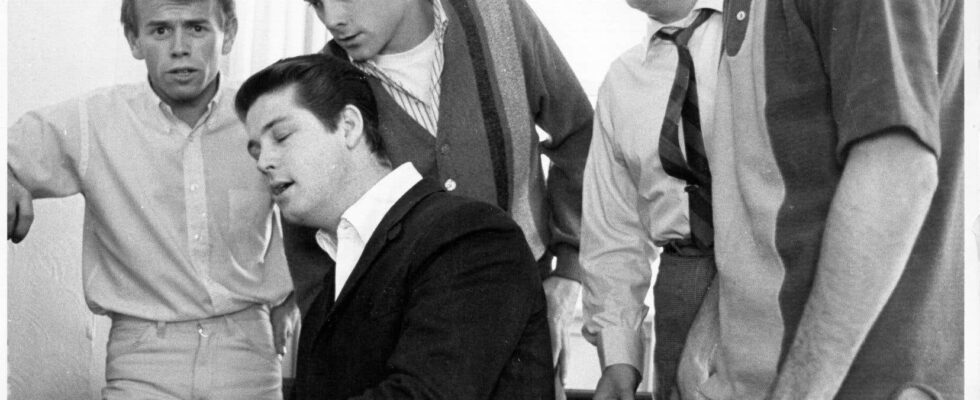Official statement from Brian Wilson regarding the retrospective portrait of Frank Marshall and Thom Zimny, simply titled The Beach Boys : “I am very happy with the result of the documentary, they did a wonderful job. It really took me back to those days with the Boys, the fun and the music. And, of course, those incredible harmonies. » The quote reached the media just in time. The next day, the news broke: due to dementia, the main creator of the Beach Boys was placed under guardianship. The very recent death of his partner Melinda – last January – after more than three decades of love and good care, gentle guardianship without the controlled designation, precipitated everything.
We were therefore able to bury for good the dead, the dying and the old droppings on our hearts under the sand of Paradise Cove, where the cover photo of the Beach Boys’ first album was taken in 1962. The last sequence of the documentary The Beach Boys was filmed there, in the presence of octogenarian boys in Hawaiian shirts: around a dazed Brian Wilson, David Marks, Al Jardine, Mike Love and Bruce Johnston toast and briefly harmonize. Full loop, clear beach?
Good and bad vibes
Nice rake, yes. Frank Marshall smiles from his side of the Zoom screen. “They are human beings, with good days and bad days. I wanted to show both sides…” But without dwelling on the constant arguments, the shoveling of legal proceedings and, above all, without showing too closely the unbearable Mike Love. The cousin. The opportunist, whose connection with the Wilsons – father Murry, sons Brian, Carl and Dennis – allowed him to demonstrate more than limited abilities. Love the commercialism, which discouraged Brian from further experimenting in the studio because it didn’t sell as much as surf anthems. Love the Ruthless, who maneuvered to become the sole owner of the rights to the name The Beach Boys en concert.
Seeing him in the documentary of Marshall and Zimny whining while talking about Brian Wilson and their “up and down” (nice euphemism for his nastiness towards the fragile and gentle genius) is something shocking. We understand the intention of the documentarians: the story must end well, it would be too sad otherwise. Marshall insists on this. “This music gave happiness to people. I wanted to explain how this happened. Above all, I wanted to give everyone their place, their role. Who was Carl Wilson? Why was Al Jardine so essential? »
Thanks to Al Jardine’s mother
Let’s ask Jardine the question, precisely. “Brian and I were neighbors [à Hawtorne, en Californie], on opposite sides of the street, on the same football team. Quite naturally, we sang, and the miracle of the Beach Boys was that each of us was in a different place in the scale. The film clearly shows how my mother [Virginia] helped us in the beginning. Murry, the Wilsons’ father, didn’t believe in us. She was the one who provided the $300 security deposit, which was over a month’s salary, to allow us to rent the equipment for our first recording. We rehearsed, rehearsed, rehearsed, then sang our two songs for her, the fast one and the slowest one, Surfin’ And Luau. We were pretty good, but still, she had to take the risk! » On the screen, Al rolls his eyes: “ Thanks mom ! »
Complex, tortuous, twisted, triumphant and tragic, the story of the Beach Boys cannot be told in a few hours, we already knew that from the — very good — documentaries The Beach Boys: It’s OK! (1976), The Beach Boys: An American Band (1985) and Endless Harmony: The Beach Boys (1998). Each has its strong beaches and shifting sands, both complementary and deficit. From the hour and 53 minutes of the most recent effort, we settle the period 1973-2020 in ten minutes. “For me, from the moment the Beach Boys became a Beach Boys tribute band, the main thing was said,” summarizes Marshall.
Documents in spades, between omissions
If we devote worthy sequences to the creation of Help Meof Rhonda and of Sloop John BAl Jardine’s most celebrated interpretations in the Beach Boys canon, that leaves out quite a few notable contributions: let’s mentions I Know There’s an Answer, Vega-Tables (with Paul McCartney chewing celery!), Cotton Fields, Lady Lynda. “The story is touched on, it must be said,” recognizes Jardine. Why not three hours? Or a multi-part documentary? There is so much more to tell. » Certainly we do not forget the connections of the hedonistic drummer Dennis Wilson with Charles Manson, the criminal guru who would have liked to be a rock star. An editorial choice of editing, as they say. At the expense of so many other less sordid and more musical episodes.
The whole Beach-Boys-sans-les-Beach-Boys part which brought us the performances of exceptional musicians around Brian Wilson, reissuing the legendary Pet Sounds on stage, completing the great work smile, is omitted from the documentary. For Jardine, however, these were the best years spent with Brian Wilson. ” What band extraordinary we had, for a whole decade without all the worries that come with Mike Love and the fight for ownership of the Beach Boys. Brian and I were not welcome in the “new revival band”, so we got around the problem. » Al Jardine looks down, a screenshot wouldn’t have been too much. “It’s all over, unfortunately. » At the presentation of the documentary The Beach Boys, at Abbey Road Studios on May 13, the only Beach Boys present? We give it to you in a thousand: Bruce Johnston and Mike Love. We have the good vibes that we arrogate to ourselves.
